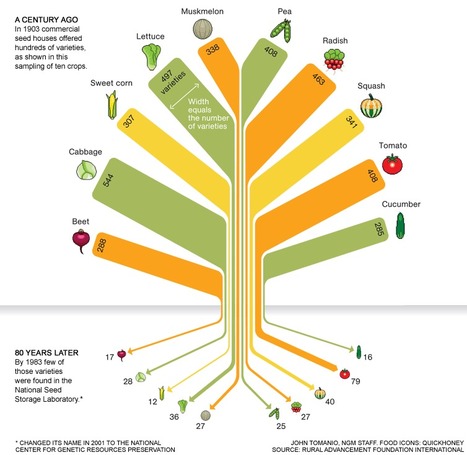Google has spent years analyzing who succeeds at the company, which has moved away from a focus on GPAs, brand name schools, and interview brain teasers. In a conversation with The New York Times' Tom Friedman, Google's head of people operations, Laszlo Bock, detailed what the company looks for. And increasingly, it's not about credentials.{{inline-ad}
Get Started for FREE
Sign up with Facebook Sign up with X
I don't have a Facebook or a X account
 Your new post is loading... Your new post is loading...
 Your new post is loading... Your new post is loading...
Alyssa Dorr's curator insight,
December 16, 2014 9:13 AM
This article is based on a study done by the Rural Advancement Foundation in 1983. Over the past century, it is hard to know what foods were lost and how many of each. But this study done by RAF gave us some information to solve the problem. It compared USDA listings of seed varieties sold by commercial U.S. seed houses in 1903 with those in the U.S. National Seed Storage Laboratory in 1983. The survey, which included 66 crops, found that about 93 percent of the varieties had gone extinct. 93 percent of these crops have gone extinct. That is a huge chunk that could be used as resources. This tree starts off with ten crops on it. The tree included: beet, cabbage, sweet corn, lettuce, muskmelon, peas, radish, squash, cucumbers, and tomatoes. In 1903, all these numbers were up, up, up. The lowest starting with beet at 288 ranging up to the highest with lettuce at 497. However, 80 years later in 1983, numbers dropped. The highest then shifted to tomatoes at 79 and the lowest shifted to sweet corn at 12. 
Alex Smiga's curator insight,
February 13, 2016 12:18 PM
From a scientific view point it almost seems like we are making ourselves into specialists in an ecological / dietary way. Limiting our available food resources and hoping against the odds that we don't suffer the same fate as other specialist species of the past. |

Shelby Porter's curator insight,
November 4, 2013 10:39 AM
It isn't surprising that the more a country has developed, the more wasteful they are. I just think that we need to change this standard. We can not keep this up if we want to sustain ourselves for centuries to come. If we are going to change our consumption culture, we need to look at why it has become the way it is. Why do we see food as unappealing? This is an interesting video and certaintly makes you think twice about throwing anything away. 
Kenny Dominguez's curator insight,
November 29, 2013 6:13 PM
Ted explains it well how we all waste perfectly good food that people would like to eat. Also it was amazing how much food was in the dumpsters that was just a day or week old. That meat could feed hundreds of people that are struggling to eat and all that meet to waste. 
megan b clement's curator insight,
December 16, 2013 1:51 AM
Ted talks about just how wasteful our planet is. How we just ignore the issue and act like it will not affect us in the future. When he shows you video and pictures of massive piles of the ends of a loaf of bread or all the food that Stop and Shop throws out because it does not "look" good for the customer. How every little bit of help counts you can try to make a little bit of an effort to be less wasteful. We have so much unnecessary waste. Like when he uses the example of how many people throw away the ends of a loaf of bread then he shows the waste of the ends of bread in massive piles it makes you sick. Especially with all of the hungry people in the world we need to be more resourceful.
|











